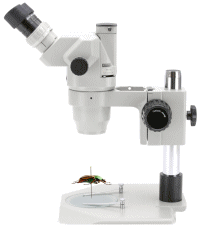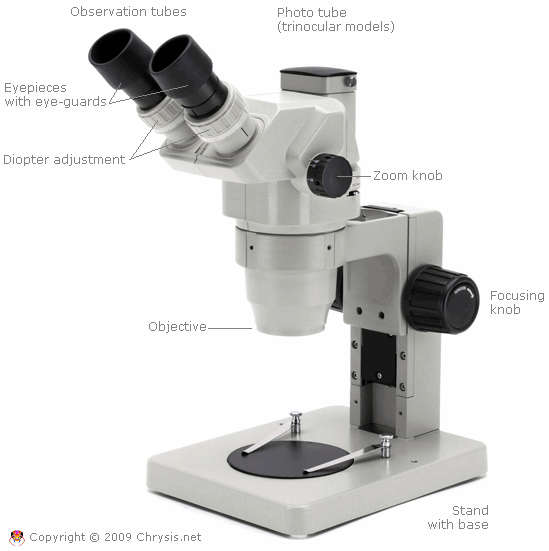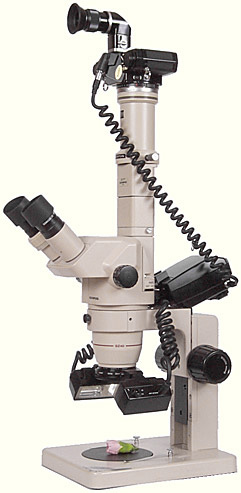Last updated on July 6th, 2020
 The entomological survey for the purpose of research, or simply the exploration of the incredible shapes hiding in the small world, requires the use of a stereoscopic microscope – also called stereomicroscope or stereo microscope.
The entomological survey for the purpose of research, or simply the exploration of the incredible shapes hiding in the small world, requires the use of a stereoscopic microscope – also called stereomicroscope or stereo microscope.
In summary, a stereo microscope is a high-magnification lens through which you can observe three-dimensional subjects. It is a rather simple optical-mechanical system: a so-called head with two observation tubes, an inner prism and lenses system and an apical lens (or objective). The knob on the column lets you move the head in order to manually focus the subject. The result is a three-dimensional view of the subject at magnifications typically ranging between 5X and 200X.
Here it is the drawing of a Olympus SZ Series trinocular stereomicroscope:

How to choose a stereomicroscope
The choice of the stereomicroscope is serious and requires time, comparison and evaluation of needs. Not for nothing it is an economically important choice which will accompany you for many years – if not for a whole life – of research. We do not suggest a particular brand or model. Of course, as everywhere, there are very special brand for the quality of their products, such as Wild, Zeiss, Leica and Olympus, but the budget needed to get those microscopes is more appropriate to a research institute than to ordinary people.
Anyway, a private person has some great options, but good options must be looked for carefully. You may look at the market of used lab equipments (eBay and specialized online shops), or you can point at the many clones of some well-known microscopes. An advantage is that there is a flourishing market of accessories (eyepieces, lights, lenses, bases, etc.), all adaptable to standard microscopes – and to their clones. One of such standard models is the Olympus SZ40, available everywhere used or reconditioned at affordable prices (a used head costs 400-500 US$). Such model counts a lot of good clones, generally from the East (China, India, Korea, etc.) and the market of accessories is huge. For example, you can wait for the chance of a used Olympus head on the eBay and then you can complete it with eyepieces, objectives, stands, lights from the many online shops or directly from the factories. In our opinion, the choice of a SZ stereo microscope is intelligent.
Features to look for
The features that you need to look for in a stereo microscope start obviously from the system’s optical quality, which should ensure high definition, contrast and clarity of the image from the center to the edges of the field of view. The field of view should be as broad as possible and wide-field eyepieces – marked with the “WF” acronym (Wide Field) – are a must.
The focusing distance should be good enough to let you work with the fingers under the objective. Classic microscopes like the Olympus SZ40 – or its many clones – ensure about 100mm of focusing distance, which is optimal. Depending on the case, this distance can be varied – increased or decreased – through the use of additional lenses.
The magnification of stereo microscope may be in steps, fixed, or continuously variable (zoom). For routine investigations, in which you need to make comparisons or measurements in series, it is preferable to have fixed magnifications (eg. 10X, 20X, 40X). Some microscopes have graduated zoom knobs with click-stops at the main steps of magnification.
Standard eyepieces have a magnification of 10X, but they can be interchanged with 15X, 20X, 25X or 30X eyepieces, which increase the total magnification without varying the working distance. The total magnification of the microscope is the product of the magnification of the eyepiece and that of the objective. For example, with a 10X eyepieces and a 1X objective you will get a total magnification of 10X (10 x 1 = 10); with a 20X eyepiece the total magnification becomes 20X.
But also the magnification of the objective can be varied thanks to the aforementioned auxiliary lenses, usually with 0.3X, 0.5X, 1.5X, 2.0X magnifications. These auxiliary lenses vary the total magnification and vary the working distance. For example, with a 10X eyepiece, a 1X objective and a 2X auxiliary lens you get 20X total magnification. The same would be obtained with 20X eyepieces and a 1X objective. But positive-power auxiliary lenses (1.5X, 2X) decrease the original focusing distance, while negative-power lenses (0.3X, 0.5X) increase the working distance, particularly useful when you cannot get too close to the subject under the microscope – or vice versa.
Magnification chart for Olympus SZ – and clones – stereomicroscopes
| Zoom objective |
Eyepiece
|
Working
distance (mm) |
||||
|
10X
|
15X
|
20X
|
25X
|
30X
|
||
|
Total
magnif. |
Total
magnif. |
Total
magnif. |
Total
magnif. |
Total
magnif. |
||
|
0.67X – 4.50X
|
6.7X-45.0X
|
10.1X-67.5X
|
13.4X-90.0X
|
16.8X-112.5X
|
20.0X-135X
|
100
|
| With auxiliary lens: | ||||||
|
0.3X
|
2.0X-13.5X
|
3.0X-20.3X
|
4.0X-27.0X
|
5.0X-33.8X
|
6.0X-40.5X
|
287
|
|
0.5X
|
3.4X-22.5X
|
5.0X-33.8X
|
6.7X-45.0X
|
8.4X-56.3X
|
10.0X-67.5X
|
177
|
|
1.5X
|
10.1X-67.5X
|
15.1X-101.3X
|
20.1X-135.0X
|
25.1X-168.8X
|
30.0X-202X
|
47
|
|
2X
|
13.4X-90.0X
|
20.1X-135X
|
26.8X-180X
|
33.5X-225X
|
40.0X-270X
|
26
|

The eyepieces tubes of the modern microscopes bear the knobs for the diopter correction – usually ± 5 diopters – allowing the focused vision also to eyeglass wearers, when they don’t wear them. In any case, the eyepieces born from a good optical design allow a good view also to eyeglass wearers with goggles worn, thanks to their high exit pupil. In addition, the interpupillary distance must be adjustable to adapt to our personal distance, to avoid the vision of a black field.
Lighting is a key issue. The ideal lighting is a cold-light ring – or close to daylight, about 5500°K. Today there are many affordable models of Fluorescent or LED ring illuminators, adjustable in intensity (dimmable) and capable of illuminating without creating shadows.

The photographic opportunities through the microscope are considerable. You can choose between trinocular microscopes – in which a third photo/video tube is connected to an analog/digital camera or to a USB camcorder – or you can find specific adapters for the standard binocular tubes. You can ask for such adapters to the online shops, directly to manufacturers or to eBay ads. And there are already several forums where you can post messages and perceive the secrets of the photography through a microscope – the photomicrography.

Copyright, Authorship, and Ownership statements
All text and images of this page are copyright ©️ Chrysis.net unless otherwise stated - please see individual cases for authorship and copyright details. The specimens pictured are from the authors' or other collaborators' personal collections and from the collections of various museums. Unless otherwise specified, the whole content of this web site is for personal, non-commercial, scientific, and educational purposes given proper accreditation to the page from which they were derived are provided, and under Chrysis.net Terms and Conditions.
For citation purposes
Agnoli G.L. & Rosa P. (2025) How to choose a stereomicroscope, in: Chrysis.net website. Interim version 12 July 2025, URL: https://www.chrysis.net/resources/how-to-choose-a-stereomicroscope/.




